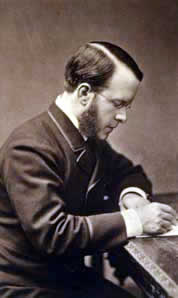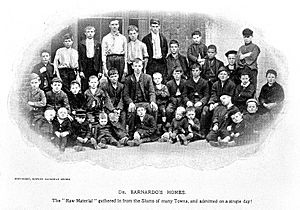Thomas John Barnardo facts for kids
Quick facts for kids
Dr Thomas John Barnardo
|
|
|---|---|
 |
|
| Born | 4 July 1845 Dublin, Ireland
|
| Died | 19 September 1905 (aged 60) London, England
|
Thomas John Barnardo (born July 4, 1845 – died September 19, 1905) was a kind-hearted person from Ireland. He started and ran many homes for children who were poor or didn't have families. By the time he passed away, his homes had helped almost 60,000 children.
Even though Barnardo didn't finish his medical studies, he was known as 'doctor'. He later earned a special license to practice.
Contents
Early Life
Thomas Barnardo was born in Dublin, Ireland, in 1845. He was one of five children. His father, John Michaelis Barnardo, was a furrier (someone who works with animal furs). His family came from Venice a long time ago.
When he was a child, Barnardo said he was a bit selfish. But as he grew up, he changed his mind. He decided he wanted to help people who were struggling. In 1866, he moved to London. There, he became very interested in helping others as a missionary.
Helping Children in Need
In 1868, Barnardo opened a special school called 'Hope Place' in the East End of London. This was his first step to help the many children living on the streets of London. About 30,000 children were very poor or had lost their parents because of a sickness called cholera.
- This school was called a 'ragged school'.
- It offered lessons based on Christian ideas, but it also taught children useful skills.
- Children learned trades like how to be a newsboy or a shoe-shiner. This helped them earn money.
In 1870, Barnardo saw how many orphaned children were sleeping on the streets. This made him open a home for boys at 18 Stepney Causeway. This was the very first of 122 homes he would open! These homes cared for over 8,500 children before he died in 1905.
- Babies and very young children were sent to homes in the countryside. This kept them safe from city pollution.
- Older children learned skills like carpentry (working with wood) and metalwork. These skills helped them get jobs later in life.
Barnardo's homes were not just for boys. In 1876, he opened the 'Girls' Village Home'. By 1905, this home helped 1,300 girls. They were trained for 'domestic occupation', which meant learning skills for working in homes.
Barnardo and his wife, Sara Louise Elmslie, also started a special place by the sea and a hospital. By the time Barnardo passed away, almost 60,000 children had been helped by his homes. Most of them were trained and found good places in life. When he died, his charity was looking after more than 8,500 children in 96 different homes.
Personal Life
In June 1873, Thomas Barnardo married Sara Louise Elmslie. She was also known as Syrie. Syrie shared her husband's passion for helping people. They lived in Essex and had seven children.
One of their daughters, Gwendolyn Maud Syrie (1879–1955), became a famous interior designer in London. She was married to a wealthy businessman and later to a writer.
Thomas Barnardo died in London on September 19, 1905. He was buried in front of Cairns House in Barkingside, Essex. This house is now the main office for the children's charity he started, Barnardo's. There is also a memorial outside the house to remember him.
Barnardo's Legacy
After Barnardo died, people wanted to make sure his work continued. They raised a lot of money to help his homes stay open forever. William Baker, who was in charge of the charity's council, took over as the new director. Barnardo himself wrote 192 books about his charity work.
His work continued under the name Dr Barnardo's Homes. Over time, society changed. In the mid-1900s, the charity started focusing more on fostering (where children live with other families) and adoption. They changed their name to Dr Barnardo's. In 1989, they closed their last traditional orphanage. Then, they simply became known as Barnardo's.
The Charity Today
Barnardo's official mascot is a bear named Barney. Queen Elizabeth II was a supporter of Barnardo's for many years. In 2016, she passed this role to The Duchess of Cornwall, who is now Queen Camilla. The current leader of Barnardo's is Lynn Perry.
See also
 In Spanish: Thomas John Barnardo para niños
In Spanish: Thomas John Barnardo para niños
- The Likes of Us
- Charitable organization
- Orphanage
- Ragged School Museum
- List of Freemasons


